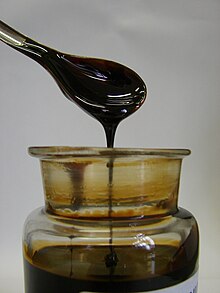Balsam of Peru
Peru balsam (Balsamum peruvianum) is a balsam that is obtained from the balsam tree ( Myroxylon balsamum var. Pereirae (Royle) Harms ). Contrary to its name, it comes from Central America and Southeast Asia , Sri Lanka . The name Peru balsam came about because Central America was part of the viceroyalty of Peru at the time of the Spanish conquest of Central and South America .
Extraction
In several places, with a little distance, the bark is pounded soft around the foot of the tree and then the bark is removed. After approx. 5 days, the escaping wound juice (balm) is absorbed with a cloth, which is called "Taguazonte" or "Tacusonte". After the first outflow ends, these spots are smoldering , after about a week then comes the balm in greater mass of. The emerging balm is also picked up with cloths, which are renewed weekly, this is repeated about three times. This is called "Balsamo de Trapo" or "Balsamo de Panal". Then the flow of balsam is stimulated again by incising and removing the excessively burned areas, as well as swelling again. After a few days, new balm comes out, which still saturates 1–2 lobes. This balm is called “Balsamo de contrapique”, it contains more impurities and less cinnamein . It is then again angschwelt, whereupon balsam comes out again, also 1–2 rags, then the areas are exhausted. It must be ensured that the discharge points are covered with balm at the end in order to close the wound areas.
The rags soaked with balm are each boiled in a pot with water, the balm (rag balm) partially settles on the bottom of the pot. The rags are then squeezed out to extract the rest of the balm. The raw balsam is heated and freed from the water, the impurities are skimmed off. Finally, the bast is scraped off, crushed and boiled, this also results in a balsam (bark balm) "Balsamo de Cascaro", which is usually mixed with the rag balm. The abge seihten pieces of bark "Estoraque" are as insect repellent in the form of incense used and more recently in skin creams. Then proceed in the same way with the next positions above the tree. The extraction takes from November to April or the end of May.
properties
Peru balsam is a dark brown, thick, non-sticky liquid with an aromatic smell reminiscent of vanilla, with a slightly bitter taste. The substance is easily soluble in ethanol and chloroform , not soluble in fatty oils (can be mixed with castor oil up to 15%), insoluble in water. It is heavier than water, the spec. Weight is 1.135-1.145.
Balsam of Peru consists of 45–75% of an ester mixture (formerly known as cinnamein), 2/3 of which is benzyl benzoate and 1/3 benzyl cinnamon ester . The substance also contains 25 to 30% resins, benzoic acid , cinnamic acid , vanillin , approx. 5% nerolidol and farnesol .
The balsam of Peru is adulterated with other balsams, rosin , benzoin and turpentine .
use
It is used in medicine as a wound healing agent (5–20%) in ointments, hemorrhoid suppositories , and in perfumery as a fixing component to convey warm sweetness. Sometimes it is used as an incense . In the Roman Catholic Church , balsam of Peru was made the official substitute for real incense for use in liturgy by a decree of Pope Pius V , as incense used to be difficult to obtain and too expensive. The scent created when burning is reminiscent of chocolate. However, the smoke of the balm strongly irritates the airways and quickly triggers violent coughing.
The Cosmetics Directive of the EU prohibits the use of balsam of Peru as a fragrance ingredient because of frequently occurring contact allergies, since July of 2005. In its place, perfume manufacturers use Peruvian balsam oil, which is considered harmless and which is obtained from the balsam by distillation.
See also
literature
- O. Anselmio, E. Gilg (Ed.): Commentary on the German Pharmacopoeia. Volume 1, 6th edition, Springer 1926, ISBN 978-3-642-88890-8 , p. 300 ff.
- Paul Preuss: Expedition to Central and South America. Publishing house of the Colonial Economic Committee, Berlin 1901, archive.org . Dogma, 2013, ISBN 978-3-95580-737-5 (Reprint), pp. 318-336.
- Norma NSR 71.52.01: 07 Salvadorena: Calidad del Bálsamo de el Salvador (Myroxylon balsamum, var.pereirae Royle Harms). Especificaciones. DIARIO OFICIAL, San Salvador 5 de Mayo de 2008, online (Spanish) (PDF; 621 kB), at faolex.fao.org, accessed on January 14, 2017.
Individual evidence
- ^ F. Berger: Handbook of drug science. Volume 6, W. Maudrich, Vienna 1964, OCLC 311654561 , p. 18.
- ^ Robert Jaretzky: Textbook of Pharmacognosy. 2nd edition, Vieweg, 1949, ISBN 978-3-663-03153-6 , p. 78 ff.
- ↑ K. Keller, G. Schneider (Ed.): Hagers Handbook of Pharmaceutical Practice. Drugs E-O , 5th edition, Springer, 1993, ISBN 978-3-642-63427-7 , p. 895.
- ↑ H. Thoms, J. Holfert: School of Pharmacy. 2nd edition, Springer 1899, ISBN 978-3-662-01975-7 , p. 174.
- ↑ Julius Wiesner : The raw materials of the plant kingdom. Engelmann, Leipzig 1873, p. 133 ff.
- ↑ a b Hermann Ammon (Ed.): Hunnius Pharmaceutical Dictionary , 8th edition, de Gruyter, Berlin 2004, ISBN 3-11-015792-6 .
- ↑ Felix Bachmair: Antimicrobial effect of selected resins on airborne germs. Diploma thesis, University of Vienna, 2013, pp. 52–55, online (PDF; 2.93 MB), at othes.univie.ac.at, accessed on January 3, 2017.
